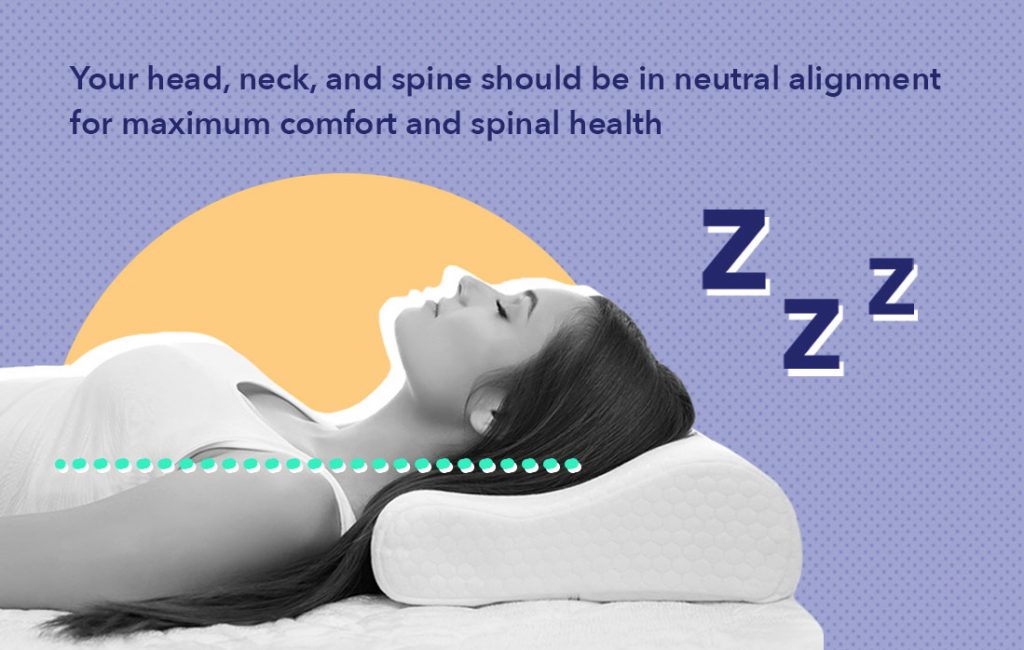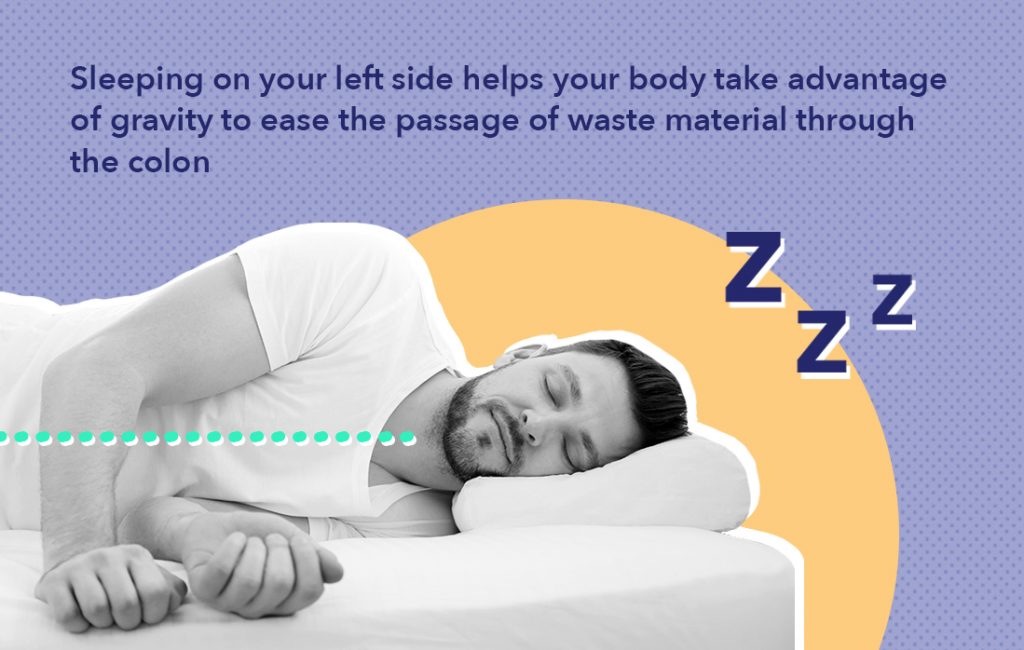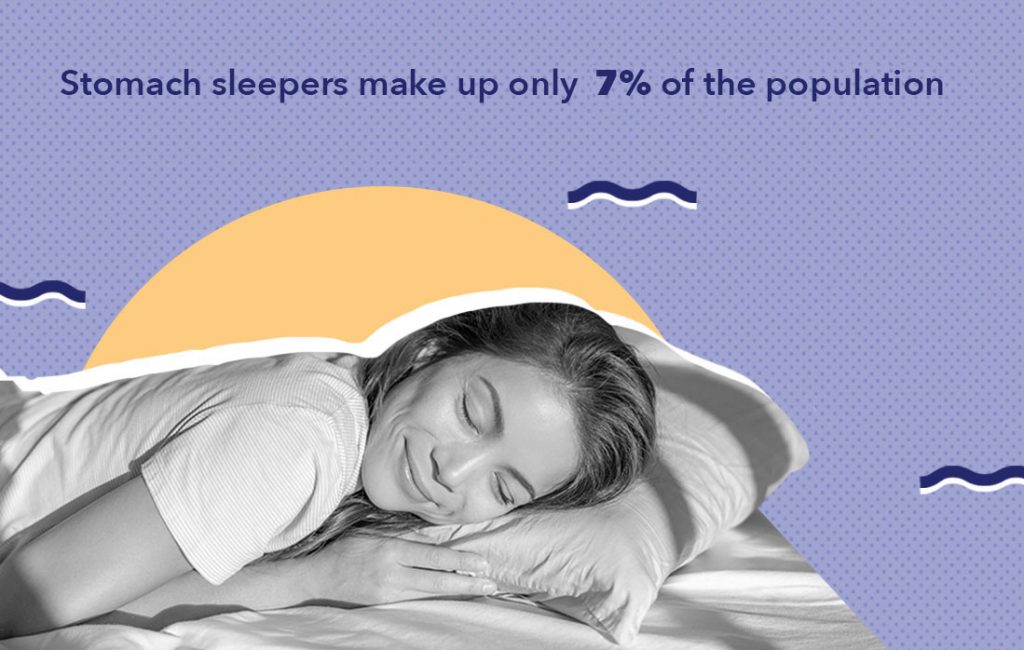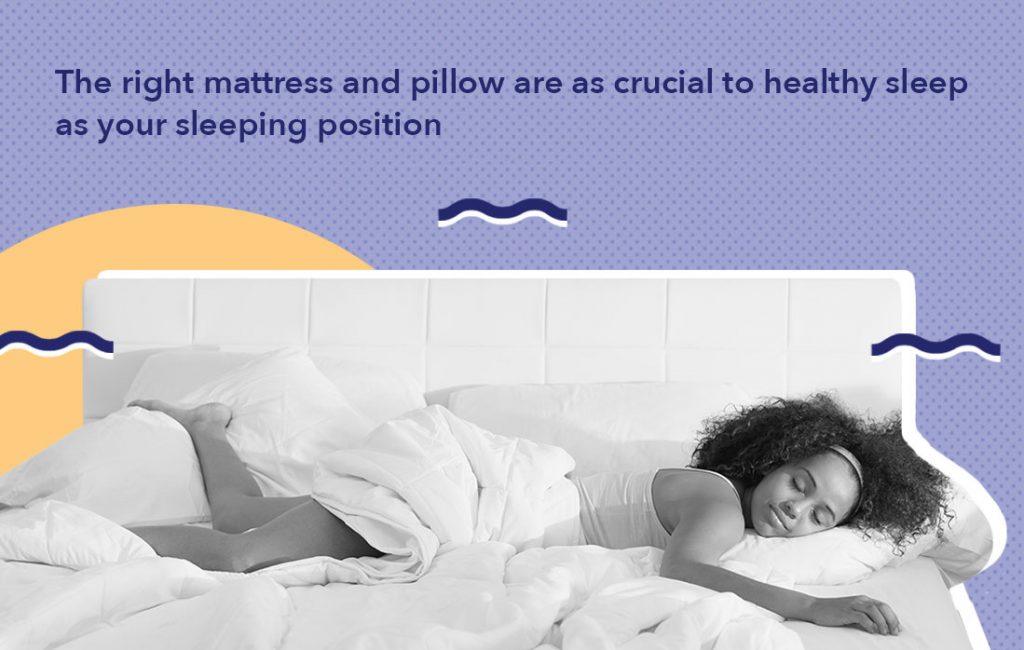Though maintaining good health depends on several factors, one of the most important is healthy sleep (1). Healthy sleep requires adequate time to rest, the ability to reduce emotional and nervous system tension, and sleep posture that does not cause or exacerbate pain. While sleep positions will change throughout the typical night, most of us have a go-to position in which we spend most of our time.
Posture
The position of the limbs or the carriage of the body.
Note: The content on Sleepopolis is meant to be informative in nature, but it shouldn’t take the place of medical advice and supervision from a trained professional. If you feel you may be suffering from any sleep disorder or medical condition, please see your healthcare provider immediately.
Sleep Positions
Though there is no single sleep position that’s best for everyone, some are healthier than others. The best sleep position is one that supports your spine’s curvature, particularly at the neck. (2) The wrong position is any position that doesn’t do this.
Sleeping in the wrong position can disrupt sleep and cause discomfort and soreness, which is no fun for anyone. But the correct position can promote deeper and more restful sleep, so you’re less likely to wake up cranky. Dr. Mark Currington, licensed chiropractor at the Dallas Lifestyle Management Clinic, says that it’s not good to sleep in a position that doesn’t support your spine. He says it can lead to poor neck posture, which increases your chance for developing arthritis.
Which sleep position is best for you? It all depends on your personal health, anatomy, and preferences. We take an in-depth look at the pros and cons of each sleep position below.
FAQ
Q: How do I know if my spine is aligned properly when I sleep? A: The spine is in neutral alignment when the ears are in line with the shoulders and the chin is in line with the sternum.Back-Sleeping
Only 8% of people sleep on their backs, which is a shame due to its many benefits. (3) Many back sleepers spend some portion of the night on their sides and their stomachs (known as combination sleepers). Folks with orthopedic conditions, or those recovering after certain types of surgery may take a particular liking to back-sleeping, especially after reading the pros below.

Pros:
- Spine Alignment. Sleeping on the back aligns the neck, spine, and head, and helps you maintain a neutral position. Neuroscientist and sleep expert, Dr. Chelsie Rohrscheib of Tatch, says back-sleeping distributes your weight evenly across the body, reducing the unnatural curving of the spine. In other words, back-sleeping can help your spine feel swell.
- Less back pain. Back sleepers may find that they have less back pain, since back-sleeping requires little effort from muscles for maintaining the correct posture. (4) And for folks who suffer from back spasms, Dr. Allen Conrad, owner of the Montgomery County Chiropractic Center, says sleeping on your back with your knees slightly bent can help.
- Orthopedic comfort. Back-sleeping minimizes tension on pressure points. This may help minimize or prevent orthopedic pain. Folks who have orthopedic pain may want to try out back-sleeping.
- Aesthetics. Back-sleeping can help prevent lines on the face from sleeping against a pillow, as well as the sagginess that may develop after years of pillow pressure against the skin from side or stomach-sleeping. If you do happen to wake up with lines on your face, you can pretend you have a face tattoo for a minute or two.
Cons:
- Acid reflux. Back-sleeping may worsen acid reflux due to the position of the esophagus, which can allow acid to flow into the throat (i.e., it makes your throat feel like it’s on fire). Elevating the neck and head can help return acid to the stomach during sleep.
- Snoring and sleep apnea. Snoring and sleep apnea may be exacerbated by sleeping on the back (5) due to the position of the tongue and muscles of the throat and palate (the roof of the mouth). Back-sleeping can allow the tongue to fall back into the throat or the muscles of the palate to collapse, blocking the airway, which isn’t great if you like breathing. Snoring and sleep apnea may also be helped by elevating the upper part of the body.
- Chronic respiratory issues. Even if you don’t have sleep apnea, you should still avoid sleeping on your back if you have any chronic respiratory issues (6) such as asthma.
- Pregnancy. Back-sleeping can decrease circulation during the second and third trimesters of pregnancy. So, it may be best to go with side-sleeping.
Tips for Back-Sleeping
- Choose a pillow specifically designed for back- or combination-sleeping. Your head, neck, and spine should be in neutral alignment for maximum comfort and spinal health. Dr. Currington says finding a cervical pillow to prevent pushing the head too far forward. He says the pillow should cradle your neck while you lie on your back.
- Dr. Gbolahan Okubadejo (Dr. Bo), spinal and orthopedic surgeon and leader of the Institute for Comprehensive Spine Care, recommends using a small washcloth to support your neck while on your back. Dr. Bo also suggests using a pillow to elevate your knees by a few inches.
- If you’re trying out back-sleeping, be patient. It may take time for your body to adjust to a different position, particularly if you’re used to sleeping exclusively on your side or stomach. To help keep you on your back, place pillows on either side of your body to prevent you from turning onto your side.
- Dr. Rohrscheib recommends using a small pillow under your head and neck — but not under your shoulders — to maintain spinal alignment. Dr. Conrad suggests using a pillow under your knees to help relieve pressure on your lower back.
- Make sleeping on your back easier by elevating your head. Try a wedge pillow or memory foam pillow that will keep its shape.
FAQ
Q: What is memory foam? A: Memory foam is made of polyurethane, and was first developed in 1966 by NASA to improve the safety of aircraft cushions.Side-Sleeping
Side-sleeping is a super popular position. Approximately 41% of people sleep on their side! That number goes up as we age, with 77% of people aged 65-75 reporting that they prefer to sleep on their side. (7)

Pros:
- Smooth digestion. Sleeping on your left side helps your body take advantage of gravity to ease the passage of waste material through the colon. This is a fancy way of saying it helps you poop better. So, sleeping on the left side is particularly helpful for people with digestive issues such as diarrhea.
- Acid reflux. Right-side-sleeping can make acid reflux worse (8) by relaxing the sphincter between the esophagus and stomach. Left-side-sleeping, however, may help reduce reflux (9) by keeping the gastric sphincter above the level of stomach acid and preventing acid from flowing into the esophagus. And who doesn’t like having a throat that isn’t filled with acid?
- Heart health. Dr. Rohrscheib suggests people who suffer from heart problems sleep on the right side. She says doing so “reduces pressure on the heart and stabilizes blood pressure and heart rate.”
- Sciatica. Dr. Conrad says that if you have sciatica, you should sleep on the side of the unaffected leg. He says bending your knees to 90 degrees and placing a pillow between your legs can help prevent nerve pain.
- Sleep apnea. Side-sleeping is better than back-sleeping for folks with sleep apnea. (10) Sleeping on either side of the body can keep the tongue and muscles of the throat and palate from falling into the throat and causing snoring or sleep apnea (11). Side-sleeping can also help open airways and promote air flow. If you’re a big fan of breathing, side-sleeping might be right for you.
- Pregnancy. Sleeping on the left side during pregnancy can keep the uterus from pressing on other organs, increasing circulation, and leading to more restful sleep. Dr. Rohrscheib agrees, saying that side-sleeping promotes better blood flow, which reduces strain on the heart. As such, she recommends pregnant people begin to sleep on their side during the third trimester if they are not already doing so. And since pregnancy is uncomfortable enough as it is, side sleeping might help.
- Brain health. Some animal studies show that side sleeping may help the body clear toxic proteins from the brain, potentially lowering the risk of dementia, Parkinson’s disease, and other neurodegenerative diseases. This may help explain the propensity for side-sleeping in both human beings and animals. (12)
Cons:
- Shoulder and arm pain. Pressure against the mattress from side-sleeping may cause shoulder or arm pain, or even numbness due to impaired circulation.
- Jaw pain. Pressure on the jaw from sleeping against a pillow or mattress may cause jaw pain or soreness. This isn’t great for people who like to do basic things like eat and talk.
- Skin wrinkling. Sleeping on the side with the face pressed against a pillow or mattress can lead to sleep lines, wrinkling, and eventual sagging of the skin.
- Hip pain. Depending on your mattress and shape, sleeping on your side can cause your hips to dip down uncomfortably. If your mattress is too firm, side-sleeping can put unnecessary pressure on your hips. Both are really unpleasant for your hips.
Tips for Side-Sleeping
- Get yourself a pillow designed for side-sleeping to help align the neck and spine. Dr. Currington says to make sure the pillow is firm enough to keep your neck in alignment with the rest of your spine. He says a soft pillow can cause your neck to drop down too far and a thick pillow can push your neck up too high.
- Dr. Bo recommends putting a thin pillow between your legs to help align your hips, pelvis, and spine. Prepare to get some use out of that ragged old pillow you have tucked away in your closet!
- To help prevent sleep lines and wrinkles, try a pillow designed to support your head and neck without touching your face.
- Choose a mattress made specifically for side sleepers.
- When sleeping in the fetal position, avoid bending the neck or spine, so that you can maintain spinal alignment and reduce the likelihood of waking up in pain (which is much worse than waking up to a loud alarm clock).
- Dr. Currington recommends sleeping on your left side because the heart, stomach, and pancreas hang to this side. He says, “Food will regurgitate back into the esophagus when on the right side, especially when you first go to sleep with some food on the stomach. It also stresses the pancreas, and the heart has to pump uphill…on the right side which creates slight strain on the heart itself. Starting on the left side allows everything to function more efficiently.”
- Get ready to stretch! Dr. Bo says to stretch your legs and face straight ahead. He says that tucking your chin can put your head in a painfully forward position.
Neurodegenerative
Resulting in or characterized by degeneration of the nervous system, especially the neurons in the brain.
Stomach-Sleeping
Now for the least popular sleep position: stomach-sleeping. Folks who sleep on their stomachs make up only 7% of the population. Stomach-sleeping is known for putting stress on the neck and spine and, according to Dr. Bo, is considered the least healthy of the sleep positions.

Pros:
- Comfort. Many stomach sleepers find lying on their stomachs comfortable and may fall asleep more easily in this position.
- Breathing. Sleeping on the stomach can help reduce the risk of snoring and sleep apnea (13). This is due to the position of the throat and tongue when you are on your stomach. This is great if you share a bed and don’t want to annoy the other person with your loud snoring.
Cons:
- Neck strain. Dr. Bo says the neck can suffer if you sleep on your stomach. The reason is because stomach-sleeping causes an imbalance in muscle tone and can make it more likely for you to injure your neck muscles.
- Pressure. Stomach-sleeping can put pressure on the nerves and muscles, creating pain, tingling, and discomfort — all of which are good to avoid.
- Facial lines. Lying with the face pressed into the pillow as happens during stomach-sleeping can cause facial sleep lines. If you don’t want one side of your face looking like a city map, it may be best to avoid sleeping facedown.
- Lower back strain. Dr. Conrad says sleeping on your stomach compresses your low back lumbar curve. He says that those with low back pain arthritis are particularly likely to feel pain when sleeping face down.
Tips for Stomach-Sleeping
- Put a pillow under your pelvis. This helps take pressure off the lower back and align the spine. This may reduce back pain and muscle strain.
- Use a flat pillow, or no pillow at all. Sleeping on the stomach puts tension on the neck by forcing it to turn to the side and putting a pillow under the head only increases this tension. Look for a flatter pillow designed specifically for stomach sleepers.
- Try a firmer mattress that will keep the hips in alignment with the shoulders. The softer the mattress, the more likely you are to sink into the surface, causing further misalignment in your neck and spine.
- Alternate the direction in which you turn your head to help relieve muscle stiffness and reduce strain on the neck.
The Importance of Your Mattress and Pillow

The right mattress and pillow are as crucial to healthy sleep as your preferred position (14). A mattress should be firm enough to provide support for the natural curve of the spine and help keep it in natural alignment. Your mattress should also be comfortable and leave you feeling rested and refreshed after a full night’s sleep. Most mattress professionals recommend replacing your mattress every eight to 10 years, or sooner if it becomes less comfortable or sags.
It may not be best to avoid replacing your pillows except once every twenty years. The primary role of the pillow is to provide support for the neck and alignment of the neck and spine. A pillow that is too full or too flat can obstruct breathing, exacerbate snoring, strain the neck or joint muscles, and cause headaches. So, like Goldilocks does in the story, you must pick the one that’s “just right.” The right pillow can relieve pressure on the spine and help your body stay in a natural posture.
To increase comfort and alignment, side sleepers may choose to place a pillow between their knees, while back-sleepers might slide one under the knees. Or you can spring for a big body pillow. A huge pillow like this, that runs from the shoulders to the knees, can also support a healthy posture and reduce vertebral strain during sleep.
Last Word From Sleepopolis
Sleep positions are as unique and individual as each one of us. Your choice of position depends on your anatomy, health, and what feels most comfortable to you. Though each sleep position has potential downsides, not all will occur with everyone. The right pillow and mattress can help maximize the comfort of your chosen position and minimize the drawbacks.
If you’re considering changing your sleep position, use a pillow designed for your brand-new position and let your body gradually adjust to it. Combined with good sleep habits, the right position can improve the quality of your sleep, help you be more alert during the day, and boost your overall health and wellbeing. We hope you enjoy finding the sleep position that’s best for you!
References
- V Vyazovskiy. Sleep, recovery, and metaregulation: explaining the benefits of sleep. Nature and Science of Sleep. Dec 17, 2015.
- Her, J et al. Development and Comparative Evaluation of New Shapes of Pillows. Journal of Physical Therapy Science. Oct 2, 2013.
- Liu, J et al. Sleep posture analysis using a dense pressure sensitive bedsheet. Pervasive and Mobile Computing. Oct 31, 2013.
- Yue, S et al. BodyCompass: Monitoring Sleep Posture with Wireless Signals. Proceedings of the ACM on Interactive, Mobile, Wearable and Ubiquitous Technologies. Jun 2020.
- Menon, A et al. Influence of Body Position on Severity of Obstructive Sleep Apnea: A Systematic Review. ISRN Otolaryngology. 2013.
- Xu, X et al. On-bed sleep posture recognition based on body-earth mover’s distance. IEEE. Dec 7, 2015.
- Skarpsno, E et al. Sleep positions and nocturnal body movements based on free-living accelerometer recordings: association with demographics, lifestyle, and insomnia symptoms. Nature and Science of Sleep. Nov 1, 2017.
- Shay, S et al. The effect of posture on gastroesophageal reflux event frequency and composition during fasting. The American Journal of Gastroenterology. 1996.
- Khoury, R et al. Influence of spontaneous sleep positions on nighttime recumbent reflux in patients with gastroesophageal reflux disease. The American Journal of Gastroenterology. Aug, 1999.
- Beattie, Z et al. Classification of Lying Position Using Load Cells under the Bed. IEEE. Jun 4, 2012.
- Pinna, G et al. Differential impact of body position on the severity of disordered breathing in heart failure patients with obstructive vs. central sleep apnoea. European Journal of Heart Failure. Oct 14, 2015.
- Lee, H et al. “The Effect of Body Posture on Brain Glymphatic Transport.” The Journal of Neuroscience. Aug 5, 2015.
- “Facts about Sleep Apnea.” Federal Motor Carrier Safety Administration. https://www.fmcsa.dot.gov/driver-safety/sleep-apnea/facts-about-sleep-apnea
- Wong, D et al. Sleeping mattress determinants and evaluation: a biomechanical review and critique. PeerJ. Jan 25, 2019.


























